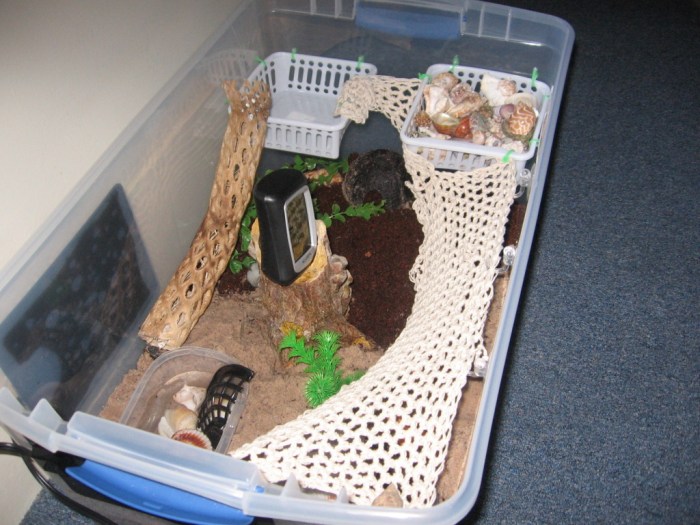DIY hermit crab cage: a captivating project for any crustacean enthusiast! Creating a thriving habitat for these fascinating creatures requires careful planning and execution. A well-designed enclosure provides a safe and stimulating environment, promoting their health and well-being.
This comprehensive guide will equip you with the knowledge and skills to construct a custom-made haven for your hermit crabs. We’ll delve into the essential components, substrate selection, water features, and enrichment ideas to create a truly enriching and fulfilling home for your beloved companions.
Substrate Selection

Choosing the right substrate for your hermit crab cage is crucial for their health and well-being. The substrate provides a vital environment for burrowing, humidity regulation, and overall comfort. It acts as a foundation for their habitat, allowing them to engage in natural behaviors that are essential for their physical and mental health.
Substrate Options
The substrate plays a significant role in maintaining the humidity and temperature levels within the cage. Let’s explore some popular options:
- Coconut Coir: This is a popular choice for hermit crab owners due to its excellent moisture retention properties. Coconut coir is a natural fiber derived from the husk of coconuts. It’s readily available, affordable, and provides a good balance of moisture and drainage. Coconut coir can be used alone or mixed with other substrates to enhance its properties.
- Sand: While sand can be a suitable substrate, it’s crucial to select the right type. Play sand, which is often found in playgrounds, is not recommended due to its potential for dust and its lack of moisture retention. Instead, opt for a finer, non-toxic sand like aquarium sand or reptile sand. These types of sand offer better burrowing opportunities and moisture control. However, sand can be prone to compaction, so regular mixing and fluffing are necessary to ensure good air circulation.
- Substrate Mix: Combining different substrates can offer a balanced and enriched environment. A popular mix involves a blend of coconut coir and sand, providing optimal humidity and burrowing opportunities. You can adjust the ratio based on your hermit crab’s preferences and the desired humidity level in the cage.
Substrate Depth and Moisture Levels
The depth of the substrate and the moisture levels are critical factors for a healthy hermit crab habitat.
- Substrate Depth: A minimum depth of 4-6 inches is recommended to allow hermit crabs to burrow and regulate their body temperature. Deeper substrate provides greater insulation and helps maintain a stable environment.
- Moisture Levels: Maintaining the appropriate moisture level is essential. The substrate should feel damp to the touch, but not soggy. A good indicator of the right moisture level is the presence of condensation on the walls of the cage. You can adjust the moisture level by adding or removing water as needed.
Creating a Balanced Substrate Mix
A balanced substrate mix provides the best environment for your hermit crab. Here’s how to create a mix that meets their needs:
- Coconut Coir: Start with a base layer of coconut coir, filling the cage to about 4-6 inches deep.
- Sand: Add a layer of fine sand on top of the coconut coir. The sand layer should be about 1-2 inches deep. This layer allows for burrowing and provides a different texture for your hermit crab to explore.
- Additional Elements: Consider adding other elements to enhance the substrate mix. For example, you can incorporate small pieces of driftwood or natural stones to create hiding spots and provide additional climbing opportunities.
Temperature and Humidity Control: Diy Hermit Crab Cage

Hermit crabs are tropical creatures that thrive in warm, humid environments. Maintaining the right temperature and humidity levels is crucial for their health and well-being. A stable environment ensures their immune system stays strong, they can molt properly, and they remain active and happy.
Monitoring and Regulating Temperature and Humidity, Diy hermit crab cage
Monitoring and regulating temperature and humidity in a DIY hermit crab cage is essential. You can use a digital thermometer and hygrometer to track these levels. Here are some ways to maintain a stable environment throughout the year:
- Heating: A heat mat or ceramic heat emitter can be used to provide warmth. Place the heat source on one side of the cage, allowing the crabs to choose their preferred temperature. The ideal temperature range is between 75-85°F (24-29°C). Avoid using incandescent light bulbs, as they can dry out the air and be a fire hazard.
- Humidity: Maintaining proper humidity is crucial. Aim for a humidity level of 70-80%. You can achieve this by using a spray bottle to mist the cage daily, providing a shallow water dish, or using a humidifier.
- Monitoring: Regularly monitor the temperature and humidity levels throughout the day. Adjust the heat source or misting frequency as needed to maintain a stable environment.
Building a DIY hermit crab cage is a rewarding endeavor that allows you to personalize their environment while ensuring their safety and comfort. By carefully considering the essential elements and incorporating creative touches, you can craft a unique and enriching habitat that will foster a happy and healthy life for your hermit crabs.
Creating a DIY hermit crab cage is a fun and rewarding project. You can use recycled materials and get creative with the design. If you’re looking for inspiration, check out these cute bedroom DIYs for ideas on how to add a touch of personality to your hermit crab’s home. Remember to include plenty of climbing branches, hiding spots, and a shallow water dish for your little crustacean friend.

